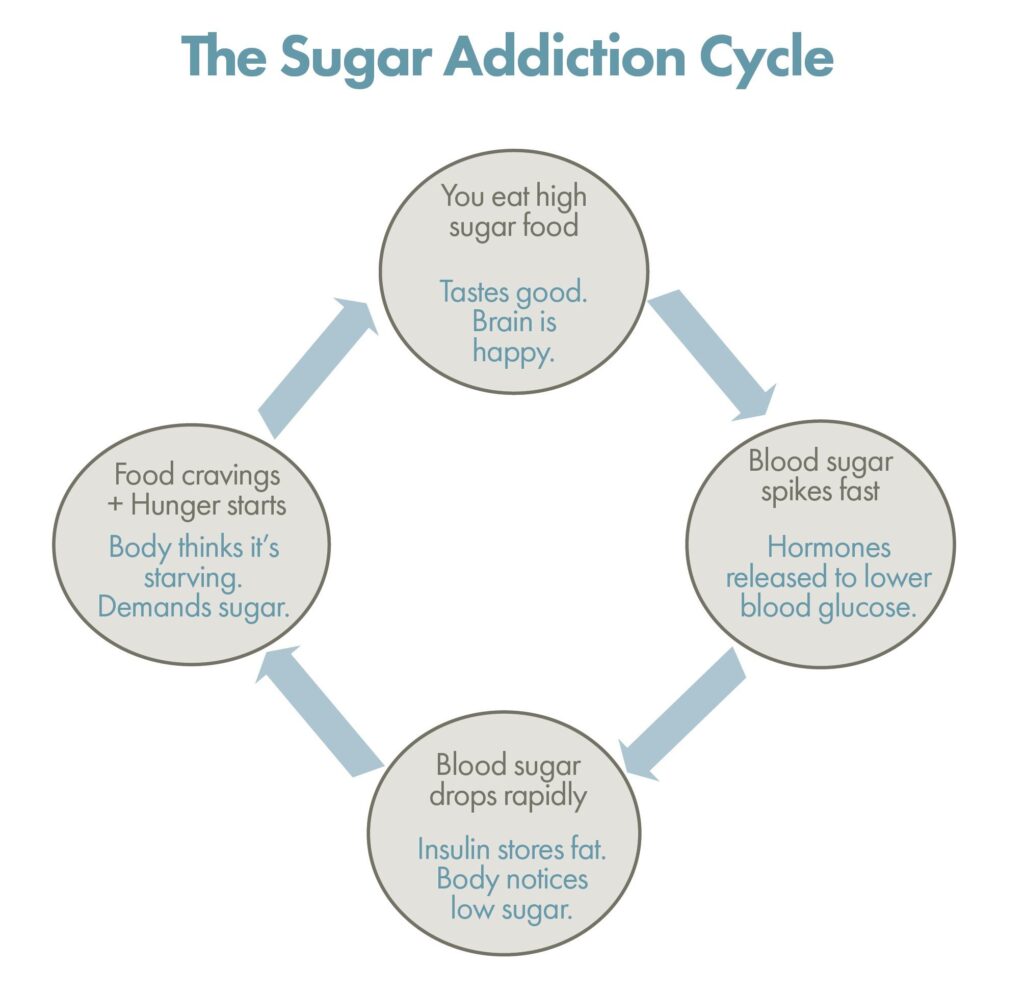In sense, it’s always “candy season” here in America. After Halloween comes Christmas, Valentine’s Day and Easter, all of which are based largely on getting consumers to buy and consume lots of candy as a key part of the celebration.
Why is sugar bad for you?
So what’s the harm in a little candy? Well considering most of us will consume more than “just a little” candy during a holiday, the impact on the body can be quite a shock.
Even though lots of candy comes in a miniature “fun size”, the calories and the effects of sugar on the body are still very apparent.
Let’s pick 3 candy favorites as an example.
- Fun-size 100 Grand bar has 95 cals and 11g sugar
- Skittles has 80 cals and 14.5g sugar
- Reese’s Peanut Butter Cup has 110 cals and 10.5g sugar
If you have one of each, that totals up to be 36g of sugar or 9 teaspoons!
It is recommended by the American Heart Association that women need no more than 100 calories daily (6 tsp) and men no more than 150 calories per day – (9 teaspoon) of added sugars. Our daily allotment can easily be met or exceeded in 3 pieces of candy, or a single soda.
Sugar is everywhere—most Americans get 1/4th or more of their total caloric intake from added sugars, such as candy, cakes, cookies, sweetened yogurt, juices and sodas. However, this does not take into account the hidden sugar in ketchup, pasta sauces, sweetened cereals, waffles, etc.
What happens to your body when you eat too much sugar?
We know too much sugar can be harmful to our health. Even so, it is a tough habit to break, especially when sweets and sodas are heavily marketed and readily available nearly everywhere at all times.
Eating too much sugar on the regular does more than just fuel cravings — it can mess with your entire body. Here’s what actually happens:
-
Blood Sugar Rollercoaster:
Sugar causes a fast spike in blood glucose, followed by a big insulin release, then a crash. This can make you feel tired, irritable, shaky, and craving more sugar. -
Brain Fog & Mood Swings:
Sugar initially boosts dopamine (the feel-good chemical), but over time, it can mess with your brain’s reward system and affect mood. It’s also been linked to anxiety, irritability, and even depression when over-consumed long-term. -
Weight Gain:
Excess sugar gets stored as fat, especially around the belly. It doesn’t satisfy hunger like protein or fat, so you often end up eating more overall. -
Increased Risk of Insulin Resistance:
Constant sugar intake can make your body stop responding properly to insulin, which may lead to pre-diabetes, type 2 diabetes, and metabolic syndrome. -
Higher Risk of Heart Disease:
Sugar increases inflammation, triglycerides, and blood pressure — all of which put stress on the heart and increase the risk of cardiovascular issues. -
Skin Problems & Aging:
Sugar can lead to breakouts and wrinkles by increasing inflammation and breaking down collagen, which keeps skin firm and smooth. -
Tooth Decay:
Bacteria in your mouth feed on sugar and produce acid that damages enamel, leading to cavities.
Cutting back doesn’t mean you need to eliminate sugar entirely, but being more mindful can significantly improve your energy, skin, mood, and long-term health.
Why is sugar so addictive?
We know that excess simple sugar increases medical risk factors for heart disease, diabetes, insulin resistance, and obesity. So why can’t we just stop eating so much of it?
Sugar feels addictive because it literally hijacks your brain’s reward system. Let’s take a look at how it works:
1. Dopamine Rush
When you eat sugar, your brain releases dopamine, the “feel-good” chemical—the same reward pathway that gets activated by things like gambling and some drugs. Additionally, the more you eat sugar, the more your brain craves that same “high”.
2. Quick Energy Spike (and Crash)
Sugar gives you a fast energy boost by spiking your blood glucose levels. But what goes up must come down — after the spike, there’s a crash, leaving you tired, irritable, and craving more sugar for another boost.
3. Built-in Evolutionary Preferences
Back in prehistoric times, sugar meant fruit — a rare, high-energy food source. So we evolved to crave sweet things for survival. Now, with sugar everywhere, that natural craving gets exploited.
4. Processed Sugar is Super Potent
Natural sugars (like those in fruits) come with fiber and nutrients. Processed sugar? It’s refined and concentrated, making it way more powerful at triggering cravings without providing anything useful to your body.
5. Habit Loops
Over time, sugary treats can become linked to comfort, boredom, or celebration. That turns cravings into habits, reinforcing the cycle.
We can think of all this as part of a feedback loop known as the sugar addiction cycle.
How to Break the Sugar Addiction Cycle
Breaking the addiction to sugar is no easy task—it’s everywhere, especially in fast or processed foods and sodas. However, there are some tried and true strategies for cutting back or rewiring your cravings. Read our Tips for Overcoming Sweet Cravings here.
For some people, it’s helpful to have the support and additional knowledge of a medical weight loss program like ours. Our doctors, nurses, and wellness coaches can work with you to create a personalized nutrition and weight loss plan that can help you overcome those cravings for sweets in a sustainable way. Contact us to learn more or take our free online health assessment to get started.




